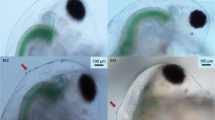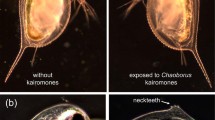Abstract
Juvenile Daphnia pulex form neckteeth in reponse to chemicals released by predatory Chaoborus crystallinus larvae. Formation of neckteeth is strongest in the second instar followed by the third instar, whereas only small neckteeth are found in the first and fourth instar of experimental clones. Predation experiments showed that body-size-dependent vulnerability of animals without neckteeth to fourth instar C. crystallinus larvae matched the pattern of neckteeth formation over the four juvenile instars. Predation experiments on D. pulex of the same clone with neckteeth showed that vulnerability to C. crystallinus predation is reduced, and that the induced protection is correlated with the degree of neckteeth formation. The pattern of neckteeth formation in successive instars is probably adaptive, and it can be concluded that neckteeth are formed to different degrees in successive instars as an evolutionary compromise to balance prediation risk and protective costs.
Similar content being viewed by others
References
Black AR, Dodson SI (1990) Demographic costs of Chaoborus-induced phenotypic plasticity in Daphnia pulex. Oecologia 83:117–122
Dodson SI (1974) Adaptive change in plankton morphology in response to size-selective predation: a new hypothesis of cyclomorphosis. Limnol Oceanogr 19:721–729
Dodson SI (1975) Predation rates of zooplankton in arctic ponds. Limnol Oceanogr 20:426–433
Dodson SI (1988) The ecological role of chemical stimuli for zooplankton: predator-avoidance behavior in Daphnia. Limnol Oceanogr 33:1431–1439
Duhr B (1955) Über Bewegung, Orientierung und Beutefang der Corthralarve (Chaoborus crystallinus de Geer). Zool Jahrb 65:387–429
Gerritsen J, Strickler JR (1977) Encounter probabilities and community structure in zooplankton: a mathematical model. J Fish Res Board Can 34:73–82
HavelJE, Dodson SI (1984) Chaoborus predation on typical and spined morphs of Daphnia pulex: behavioral observations. Limnol Oceanogr 29:487–494
Havel JE, Dodson SI (1987) Reproductive costs of Chaoborus-induced polymorphism in Daphnia pulex. Hydrobiologia 150:273–281
Hebert PDN, Grewe PM (1985) Chaoborus-induced shifts in the morphology of Daphnia ambigua. Limnol Oceanogr 30:1291–1297
Krueger DA, Dodson SI (1981) Embryological induction and predation ecology in Daphnia pulex. Limnol Oceanogr 26:219–223
Larsson P, Dodson SI (1993) Chemical communication in planktonic animals. Arch Hydrobiol 129:129–155
Parejko K (1991) Predation by chaoborids on typical and spined Daphnia pulex. Freshwat Biol 25:211–217
Pastorok RA (1980) Selection of prey by Chaoborus larvae: a review and new evidence for behavioral flexibility. In: Kerfoot WC (ed) Evolution and ecology of zooplankton communities. New England, Hanover, pp 538–554
Pastorok RA (1981) Prey vulnerability and size selection by Chaoborus larvae. Ecology 62:1311–1324
Ramcharan CW, Dodson SI, Lee J (1992) Predation risk, prey behavior, and feeding rate in Daphnia pulex. Can J Fish Aquat Sci 49:159–165
Riessen HP, Sprules WG (1990) Demographic costs of antipredator defenses in Daphnia pulex. Ecology 71:1536–1546
Riessen HP, O'Brien WJ, Loveless B (1984) An analysis of the components of Chaoborus predation on zooplankton and the calculation of relative prey vulnerabilities. Ecology 65:514–522
Sih A (1987) Predators and prey lifestyle: an evolutionary and ecological overvie. In: Kerfoot WC, Sih A (eds) Predation: direct and indirect impacts on aquatic communities. New England, Hanover, pp 203–224
Swift MC (1992) Prey capture by the four larval instars of Chaoborus crystallinus. Limnol Oceanogr 37:14–24
Swift MC, Fedorenko AY (1975) Some aspects of the prey capture by Chaoborus larvae. Limnol Oceanogr 20:418–425
Tollrian R (1993) Neckteeth formation in Daphnia pulex as an example of continuous phenotypic plasticity: morphological effects of Chaoborus kairomone concentration and their quantification. J Plankton Res 15:1309–1318
Tollrian R, Elert E von (1994) Enrichment and purification of Chaoborus kairomone from water: further steps towards its chemical characterization. Limnol Oceanogr 39:788–796
Vanni MJ (1988) Freshwater zooplankton community structure: introduction of large invertebrate predators and large herbivores to a small-species community. Can J Fish Aquat Sci 45:1758–1770
Vinyard GL, Menger RA (1980) Chaoborus americanus predation on various zooplankters: functional response and behavioral observations. Oecologia 45:90–93
Walls M, Ketola M (1989) Effects of predator-induced spines on individual fitness in Daphnia pulex. Limnol Oceanogr 34:390–396
Zaret TM (1980) Predation and freshwater communities. Yale University Press, New Haven and London
Author information
Authors and Affiliations
Rights and permissions
About this article
Cite this article
Tollrian, R. Chaoborus crystallinus predation on Daphnia pulex: can induced morphological changes balance effects of body size on vulnerability?. Oecologia 101, 151–155 (1995). https://doi.org/10.1007/BF00317278
Received:
Accepted:
Issue Date:
DOI: https://doi.org/10.1007/BF00317278




